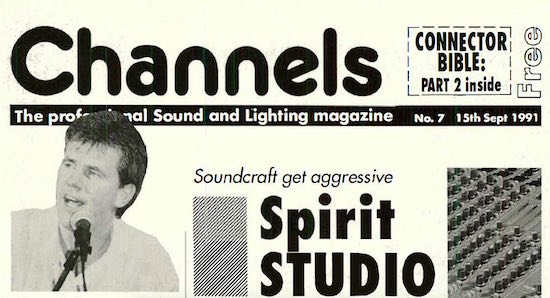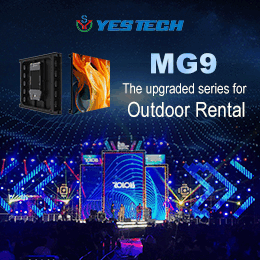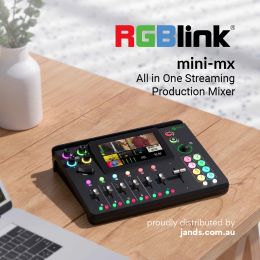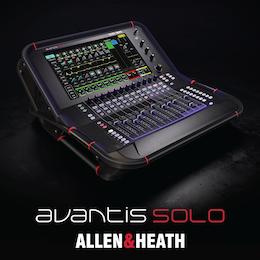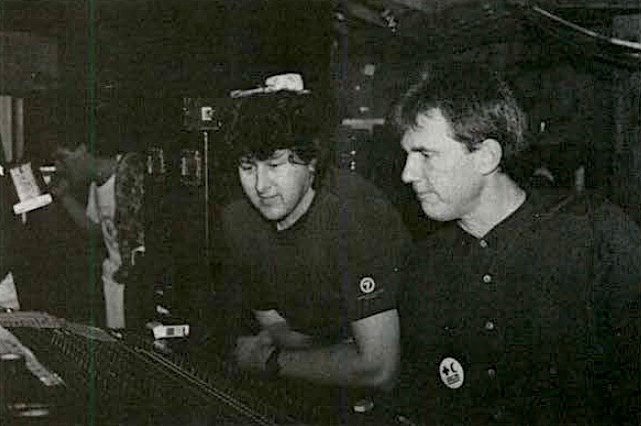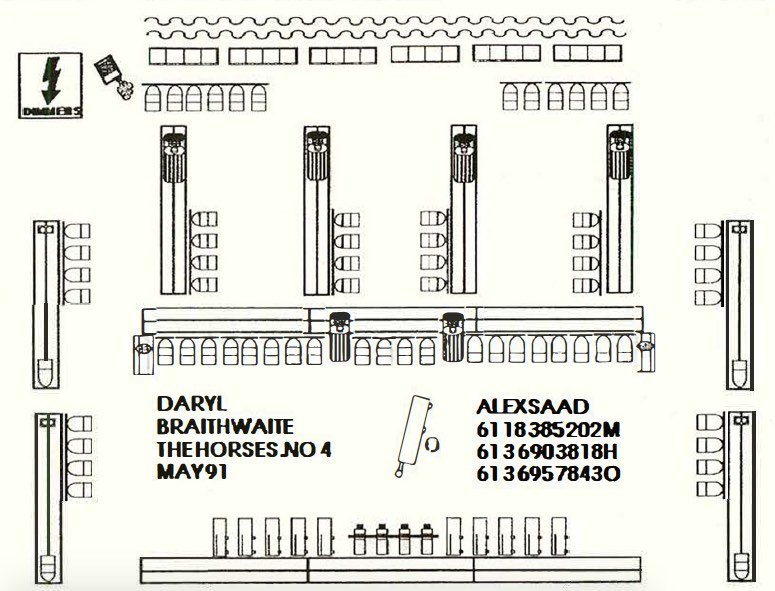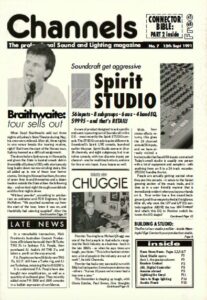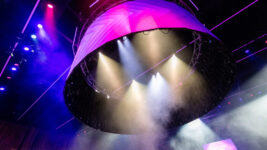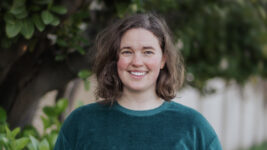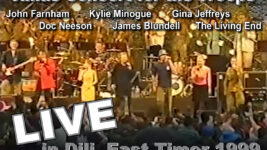Subscribe to CX E-News
History
We have covered a lot of touring productions since 1990. Here’s a story about Daryl Braithwaite’s The Horses tour from Channels magazine, September 1991.
Braithwaite: Tour Sells Out
by Julius Grafton.
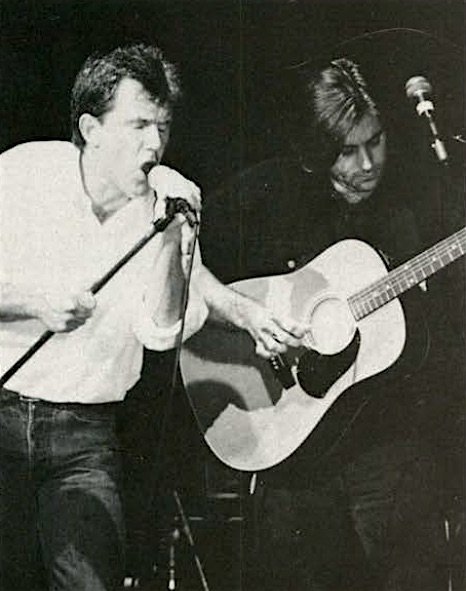 When Daryl Braithwaite sold out three nights at Sydney’s State Theatre during May; his crew were relieved. After all, three nights in one venue breaks the touring routine, right? But from the start of the Horses tour, Sydney loomed as a difficult assignment.
When Daryl Braithwaite sold out three nights at Sydney’s State Theatre during May; his crew were relieved. After all, three nights in one venue breaks the touring routine, right? But from the start of the Horses tour, Sydney loomed as a difficult assignment.
The show before Sydney was in Newcastle, and given the State is located smack dab in the middle of Sydney’s CBD, with a torturously long load-in down narrow winding stairs, this all added up to one of those tour horror stories.
Driving to Newcastle at6am, the crew of seven then found themselves and a dozen loaders outside the State at 6am the following day -and worked, right through soundcheck and the first nights show.
“Without powder”, according to production co-ordinator and FOH Engineer, Brian McMahon. “We psyched ourselves up from the start of the tour, knew it was on, and thankfully had catering supplied”.
After the third show, the crew packed and loaded out, then went straight to the airport for a flight to Melbourne at 8am. Clearly Daryl Braithwaite has a crew that would walk over broken glass for him,and it’s clear he appreciates them, for there is a genuine air of professional respect within the Braithwaite organisation.
McMahon chose a Meyer sound system, provided by Melbourne’s Troy Balance Corporation, having used Troy previously with Braithwaite.
McMahon’s choice of Meyer made sound distribution in the theatre reasonably easy, given the fairly small size of the l0 x MSL-3’s, 6 x subwoofers, and 4 x UPA-l’s that comprised the rig. At each side of the stage McMahon stacked a pair of MSL’s on a riser, with a single MS Latop -this was to service the Mezzanine level.
Flown under a single chain motor at each side of the proscenium was a further pair of MSL’s, for the dress circle. Three subwoofers sat on the floor at each side of the stage front. A pair of UPA’s provided front fill, the first rows in this Theatre NEVER receive much in the way of mid-high’s, and a separate fill send is the way to keep the paying customers happy.
Because of this zoning type distribution, McMahon ran three stereo mixes – one for each of the Theatre’s three levels, along with a mono subwoofer mix, and a front fill mix. The stereo mixes came from the left/right programme output of the Yamaha PM 2000 console, with the other pair of mixes originating from the matrix outputs.
From where he engineered the show, it was guess-work as to how it sounded throughout the theatre, so he made time to listen each to zone during the first soundcheck.
The32 channel PM 2000was supplemented by a 1516 16 channel wing board, giving McMahon 48 inputs, all of which were used, along with a few more. 33 stage lines were joined at the consoles by effects returns. Effects were 4 x SPX 9011’s, 1 x SPX 1000, 1 x Rev 7 and a D1500 delay, joined by 6 x DBX160X compressor/limiters, and 3 stereo pairs of noise gates for the kit of drums. The D1500 is used for longer (600 – 800ms) delays on Vocals.
Brian used a BPM (beats per minute) timing chart to set his reverbs and delays. “It’s handy because you can work right down to you pre-delays on your reverbs, and gate times for gated reverbs too.
“When it’s locked in it’s quite amazing, especially when you’re gating reverbs on drums you can get them opening & closing perfectly with the kick and snare just through your timing charts, that’s assuming your drummer’s playing in time!”
At the stage, Shure Beta 58’s were used for vocals, SM 57’s on drums and even Kick. Beyer 20l’s were used for overheads and hi hats and SM 57’s on Guitars and Brass. Monitor engineer Mark Brown was driving 12 sends from his modified PM 2000 32 channel console, consisting of stereo side-fill (EV Deltamax), 2 guitarist’s sends, main vocals, stereo keyboards, a wedge under the drum riser for whoever stands in front of the drums, brass, bass player, and stereo drumfill; a pair of Meyer USW subs and 2 x UMl.
The wedges were Troy’s Lord Nelson custom made examples, some with 2441 JBL compression drivers and some with Yamaha 1″ compression drivers. All had 15″ JBL low frequency drivers, and were actively biamped via cards in the Yamaha P2200 & PC2002 amps. The Yamaha QI 027 third octave equalisers were inserted over the PM 2000’s outputs, so as to allow AFL monitoring of the fully equalised sends.
The PM 2000 foldback modification entails replacing the eight subgroup assignment switches at the top of each input module, with 8 rotary pots. These become the main 8sends, with the consoles standard four monitor sends allowing 12 post fader, post EQ discrete sends.
The two effects sends on each channel were used for – two effects, funny enough, an SPX 90 (for vocal reverb) and a REV 7 for the trumpeter.
Mr. Brown kept his customers happy, the band after all comprised 2 guitarists, one backup vocalist with some percussive parts, 2 part brass section with percussion, keyboardist with off-stage rack of modules, walk on pianist during part of the show, bass, drums, and Daryl Braithwaite – who also plays acoustic guitar at whim.
Plenty going on.
It’s worth mentioning in closing that not only did this crew and band work in harmony, but also without a tour manager as such. Given the tour was performing well, that’s professionalism all round.
Lighting The Daryl
Alex Saad’s Lightweight rig uses intellabeams, and just 80 lanterns on a concert tour!
Programmable moving beam devices don’t just spice up a shows visuals, they cut down the size of the light rig too. This was evident on Daryl Braithwaite’s The Horses Tour, with a lightrig comprising 80 odd lanterns – and 6 High End Systems lntellabeams, a smaller rig for Theatre sized shows.
L.D. Alex Saad travelled light (no pun intended) with 16 VNSP, 48 Rays, 10 650w profiles, 4 Solar 250 effect projectors, 6 cyc 4’s and a bunch of Molephays, driven by a Jands Instinct 60 channel console.
“I love the Instinct, I can get ’round it quite well”, Alex said.
The intellabeams take DMX 512 control protocol, a mic cable is daisy chained from unit to unit. Because Clearlight use a five channel Weiland cable system, power for the intellabeam can be picked up from the adjoining bar of four Rays.
With a 400 watt MSR lamp, the intellabeam is fired up and left on. Inside there is a colour disk of 11 colours plus open white, a gobo disc of 11 patterns plus open, a gate wheel, and an iris. At the front, the moving of the beam is achieved by a mirror that whizzes about.
As detailed on the plot (below), the rig comprised a front and rear truss, with four smaller trusses running downstage at the back. The pair of trusses at the extreme stage sides were actually standing vertically, and a single can lit each of these four sections for effect! These “truss toners” looked good too.
Alex drove the Instinct, called the two domes, (a.k.a. followspots) and sequenced the intellabeams via the Intellabeam controller for the two hour plus show, as well as calling a rear drop in and out, giving either white eye or black backdrop effect to the show.
The two vertical floor standing trusses on each side of the stage were rigged with VNSP Par 64’s, and provided a four colour wash coloured with LEE 106 (red), 132 (deep blue), 135 (dark amber) and 126 (purple).
The two groups of 6 Rays at stage rear were rigged on stands, and coloured 181 (congo blue – a very deep, almost ultraviolet type blue) and open white. They just peeped over the tops of the risers.
At the Cyc, the four colours were 106, 132, 139 (green), and 181 again. Alex arranged the eye lights in two groups, so one side of the eye could be coloured differently to the other – which makes the little wrinkles that always happen in a cyc look really cute. It added depth.
On the front truss the 10 650w profiles (15/ 32’s) were open white, and one pair of Solar 250 projectors were fitted with cloud wheels, while another pair of projectors had a funky 3″ kinetic effect like an imploding star! For a little (250 watt, halogen) projector, these creatures manage to deliver the goods.
Your writer has always been a Solar 250 fan.
In performance mode the show worked well, the intellabeams shooting onto various soloists and modulating all over the place. Alex seemed to have enough memories stored to keep it different through the whole two hours, and worked the sometimes cyc, sometimes back black drop varieties well also. The back four Intellabeam trusses were also rigged to raise and lower also, for variety.
Perhaps the arduous nature of this run of shows (discussed elsewhere in this issue) was the cause, but the one problem with the rig at the State Theatre was the use of a front truss on stands, which wasn’t high enough for the upper circle sightlines, obscuring the rear risers.
Nevertheless, boss Daryl Braithwaite recognised the problem and worked forward in any case. In fact he worked everywhere, even in the audience. He made humour out of it, a logistic problem many other performers wouldn’t notice nor care about.
A pair of chain motors would have hoisted the truss the extra 3 metres or so needed, but… that’s life on the road! The punters left smiling, and that’s what it’s all about – isn’t it?
From Channels – September 1991. CX Magazine is Australia and New Zealand’s only publication dedicated to entertainment technology news and issues – available in print and online. Read all editions for free or search our archive www.cxnetwork.com.au
© CX Media
Subscribe
Published monthly since 1991, our famous AV industry magazine is free for download or pay for print. Subscribers also receive CX News, our free weekly email with the latest industry news and jobs.


